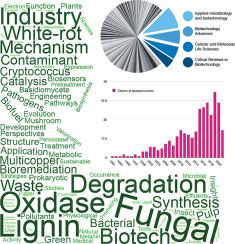Biotechnology Advances ( IF 16.0 ) Pub Date : 2021-07-29 , DOI: 10.1016/j.biotechadv.2021.107809 Laure M C Leynaud Kieffer Curran 1 , Le Thanh Mai Pham 2 , Kenneth L Sale 2 , Blake A Simmons 3

|
Development and deployment of commercial biorefineries based on conversion of lignocellulosic biomass into biofuels and bioproducts faces many challenges that must be addressed before they are commercially viable. One of the biggest challenges faced is the efficient and scalable valorization of lignin, one of the three major components of the plant cell wall. Lignin is the most abundant aromatic biopolymer on earth, and its presence hinders the extraction of cellulose and hemicellulose that is essential to biochemical conversion of lignocellulose to fuels and chemicals. There has been a significant amount of work over the past 20 years that has sought to develop innovative processes designed to extract and recycle lignin into valuable compounds and help reduce the overall costs of the biorefinery process. Due to the complex matrix of lignin, which is essential for plant survival, the development of a reliable and efficient lignin conversion technology has been difficult to achieve. One approach that has received significant interest relies on the use of enzymes, notably laccases, a class of multi‑copper green oxidative enzymes that catalyze bond breaking in lignin to produce smaller oligomers. In this review, we first assess the different innovations of lignin valorization using laccases within the context of a biorefinery process, and then assess the latest economical advances that these innovations offered. Finally, we review laccase characterization and optimization, as well as the prospects and bottlenecks of this class of enzymes within the industrial and biorefining sectors.
中文翻译:

回顾漆酶开发的进展,以提高木质素的价值,以生产木质纤维素生物燃料和生物产品
基于将木质纤维素生物质转化为生物燃料和生物产品的商业生物精炼厂的开发和部署面临许多挑战,必须在它们具有商业可行性之前解决这些挑战。面临的最大挑战之一是木质素的有效和可扩展的增值,木质素是植物细胞壁的三个主要成分之一。木质素是地球上最丰富的芳香族生物聚合物,它的存在阻碍了纤维素和半纤维素的提取,而这对于将木质纤维素生化转化为燃料和化学品至关重要。在过去的 20 年中,有大量工作致力于开发创新工艺,旨在将木质素提取和再循环成有价值的化合物,并帮助降低生物精炼工艺的总体成本。由于木质素的复杂基质,这是植物生存所必需的,但开发可靠且高效的木质素转化技术一直难以实现。一种受到极大关注的方法依赖于使用酶,特别是漆酶,这是一类多铜绿色氧化酶,可催化木质素中的键断裂以产生较小的低聚物。在这篇综述中,我们首先评估了在生物精炼过程中使用漆酶进行木质素增值的不同创新,然后评估这些创新提供的最新经济进展。最后,我们回顾了漆酶的表征和优化,以及这类酶在工业和生物精炼领域的前景和瓶颈。开发可靠且高效的木质素转化技术一直难以实现。一种受到极大关注的方法依赖于使用酶,特别是漆酶,这是一类多铜绿色氧化酶,可催化木质素中的键断裂以产生较小的低聚物。在这篇综述中,我们首先评估了在生物精炼过程中使用漆酶进行木质素增值的不同创新,然后评估这些创新提供的最新经济进展。最后,我们回顾了漆酶的表征和优化,以及这类酶在工业和生物精炼领域的前景和瓶颈。开发可靠且高效的木质素转化技术一直难以实现。一种受到极大关注的方法依赖于使用酶,特别是漆酶,这是一类多铜绿色氧化酶,可催化木质素中的键断裂以产生较小的低聚物。在这篇综述中,我们首先评估了在生物精炼过程中使用漆酶进行木质素增值的不同创新,然后评估这些创新提供的最新经济进展。最后,我们回顾了漆酶的表征和优化,以及这类酶在工业和生物精炼领域的前景和瓶颈。一类多铜绿色氧化酶,可催化木质素中的键断裂以产生较小的低聚物。在这篇综述中,我们首先评估了在生物精炼过程中使用漆酶进行木质素增值的不同创新,然后评估这些创新提供的最新经济进展。最后,我们回顾了漆酶的表征和优化,以及这类酶在工业和生物精炼领域的前景和瓶颈。一类多铜绿色氧化酶,可催化木质素中的键断裂以产生较小的低聚物。在这篇综述中,我们首先评估了在生物精炼过程中使用漆酶进行木质素增值的不同创新,然后评估这些创新提供的最新经济进展。最后,我们回顾了漆酶的表征和优化,以及这类酶在工业和生物精炼领域的前景和瓶颈。


























 京公网安备 11010802027423号
京公网安备 11010802027423号